This book is a thorough and wide-ranging exploration of the different senses that creatures possess in the animal kingdom. It’s organised by sense and starts with the senses that we share as humans, comparing them with the capabilities of the equivalent senses in animals. I was pleasantly surprised to learn that humans do OK on the visual front compared to many other animals. We see in 3 colours, which is relatively rare among mammals (although there are creatures that can see in more colours than us) and we have quite detailed vision. (I’m not sure why this type of book has me rooting for my own species in this way!)
In each chapter we learn about creatures that have different variations of the sense in question. In some cases these are minor variations to what we’re familiar with from our own experiences and in others they are wildly different.
It’s fairly easy to imagine how animals with two forward-facing eyes perceive the world. But it’s almost impossible to imagine how a creature such as a scallop with dozens of eyes perceives things. And that’s before we get to senses that we humans don’t have, such as the echolocation that bats use, the electroreception of sharks and other fish, or the magnetic sense that birds have for navigating long distances on their migratory flights.
At each new sense I found it fun to try to imagine what it would be like to experience that sense. This is basically impossible - even the word “imagine” implies a visual sense - and the book often makes reference to the philosopher Thomas Nagel’s question about what it would be like to be a bat. In fact the book makes the case that it might be harder to imagine what it’s like to be an octopus, whose tentacles have their own senses and make their own decisions. (See Other Minds for more on octopus cognition.) Along with the section on bat echolocation, the book touches on some of the same ground as Livewired by meeting humans who use a primitive form of echolocation to navigate around, so at least we can ask them how they experience the world using this sense.
A really interesting section of the book concerns the sensory pollution that humans create, and how this affects animals. There are many frequencies of light and sound, as well as radiation of other types, that humans can’t perceive but which our machinery emits. This can interfere with how animals sense the world and communicate with each other, and the book examines the implications of this.
The study of animal senses is challenging from a scientific perspective. In the section on magnetoreception the author examines some of the reasons for this. The study of magnetoreception is particularly challenging for various reasons, not least because humans don’t have this sense and have to rely on equipment to measure magnetic fields, so mistakes are easier to make. In this section the book covers some of the same ground as books like Science Fictions by talking about the ways that incorrect results can get published.
This book is really well written and well structured. The author manages to pull together examples from so many different animals, yet the book remains coherent and easy to read. It contains helpful diagrams as well as several beautiful colour photographs of the key animals in the book. I really enjoyed thinking about the perceptions of animals and I found this book absolutely fascinating and thought-provoking.
